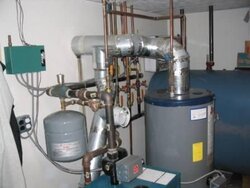I have a 3 story chalet style house, ground floor/basement it a walk out finished basement, main/2nd story is most of the living space, 3rd story is 2 small bedrooms at the peak of the roof. Part of the finished basement is the utility room which houses the oil fired boiler and hot water heater, attached is a copy of the set up. This system is not orginal to the house, it was installed 5 or 6 years ago and is vented to an outdoor clay lined cinder block chimney. Note, the woodstove is not connected to this chimney.The wood stove is on the main/2nd story and does a great job heating the upper 2 floors. As I don't use the basement much, except for entry and exit, I have a small oil filled electric radiator to keep it around 62*. Each floor has its own heating zone. Thus there is little call for the boiler.
Recently I noticed a fuel oil smell when the DHW and/or boiler fired up. This is my 3rd winter in the house, and since the boiler doesn't run much, I did not have it serviced this year on the advice of the tech who serviced it 2 years ago. Thinking there was a problem with one of the oil burners, I had the furnace guy take a look. Both burners were fine. He thought it was a venting problem. So, had my chimney sweep come over and take a look. The chimney was clean with no obstructions. His opinion was that because it is an outside chimney and temps have been in the teens, the cold air was keeping the system from venting properly. A cold chimney just doesn't draw as well. He also thought it should be about 6 ft higher perhaps, and that a draft inducer might be the answer. Where the galvanized stove pipe goes thru the wall is ground level.
He also thought it should be about 6 ft higher perhaps, and that a draft inducer might be the answer. Where the galvanized stove pipe goes thru the wall is ground level.
For the past few days, I've shut the electric heater off in the basement and set the thermostat for that zone at 66*. So, the boiler now runs every couple of hours, at least for that zone. This seems to have
helped, I don't notice any fuel oil/exhaust smell.
What are folks experiences with draft inducers? How reliable, do they really work? Would I need 2, one for the boiler and one for HW? Not a whole lot of room on the vent pipes. Thanks for any input and advice
Recently I noticed a fuel oil smell when the DHW and/or boiler fired up. This is my 3rd winter in the house, and since the boiler doesn't run much, I did not have it serviced this year on the advice of the tech who serviced it 2 years ago. Thinking there was a problem with one of the oil burners, I had the furnace guy take a look. Both burners were fine. He thought it was a venting problem. So, had my chimney sweep come over and take a look. The chimney was clean with no obstructions. His opinion was that because it is an outside chimney and temps have been in the teens, the cold air was keeping the system from venting properly. A cold chimney just doesn't draw as well.
 He also thought it should be about 6 ft higher perhaps, and that a draft inducer might be the answer. Where the galvanized stove pipe goes thru the wall is ground level.
He also thought it should be about 6 ft higher perhaps, and that a draft inducer might be the answer. Where the galvanized stove pipe goes thru the wall is ground level.For the past few days, I've shut the electric heater off in the basement and set the thermostat for that zone at 66*. So, the boiler now runs every couple of hours, at least for that zone. This seems to have
helped, I don't notice any fuel oil/exhaust smell.
What are folks experiences with draft inducers? How reliable, do they really work? Would I need 2, one for the boiler and one for HW? Not a whole lot of room on the vent pipes. Thanks for any input and advice

